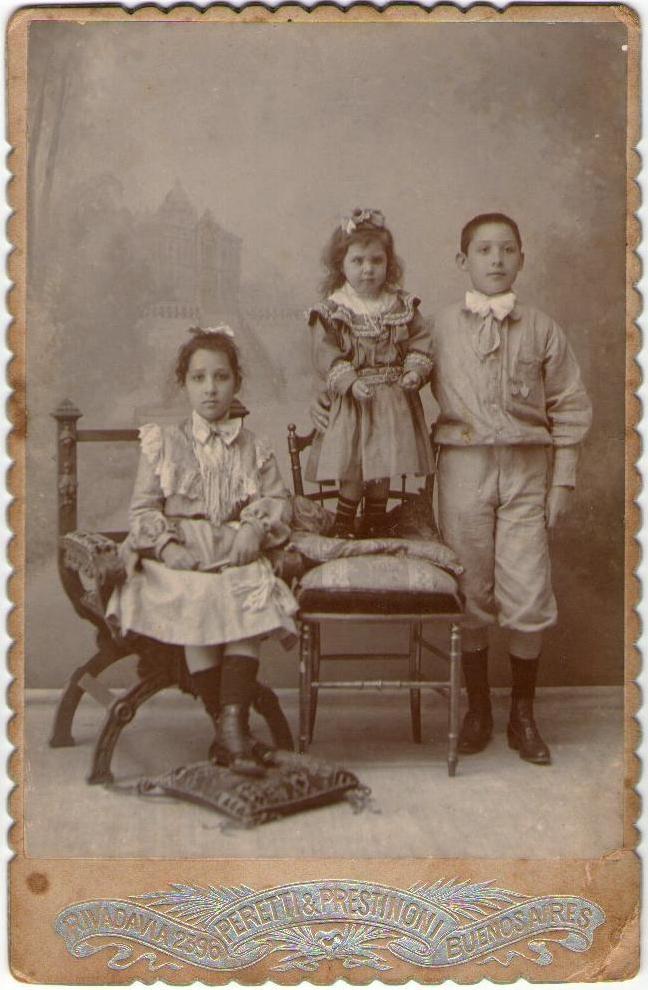
Argentine Photography

Figure 1.-- Mounts can help date cabinet cards. This Argentine caninet card was incribed, "Recuerdos de la Infancia. Año 1901" We notice this style of
pinking in America dated about 1888-95, this one is dated a little later, 1901. The mount style and the outfit the boy is wearing look more European than American and is a turn-of the century style. Wearing socks rather than long stockings is much more European than American. The studio was Peretti Prestinoni in Buenos Aires. Note the Italian name of the studio.
|
|
We have not yet found a historicl assessment of Argentine photogrophy. We believe it was for many years largely a reflection of work done by European immigrants. We can only begin to piece together some information based on the limited Argentine photograohic record we have been able to archive. The economic progress being made in Argentina during the late-19th and early-20th century was reflected in the photographic record during this period. Photograph is in part a marker for economic affluence. That is why there is a larger Argentine photographic record for Argentina than any other Latin American country, including Brazil. We have not yet found many Argentine CDVs. We do not yet if they were not very common or if reflects our limited archive. We have found some cabinet cabinet cards that to have been done in considerable numbers beginning in the late-19th century. We begin to see substantial numbers beginning in the 1890s. The styles of the card mounts seem similar to those we see in America and Britain. Trends seem similar, but we do note some chronological differences. Other photographic trends with the turn-of-the 20th century also seem similar to Europe and America. We also note similar trends in anateur snapshots. Some photographers seem to have used pper more commo with snapshots in America.
History
We have not yet found a historicl assessment of Argentine photogrophy. We believe it was for many years largely a reflection of work done by European immigrants. We can only begin to piece together some information based on the limited Argentine photograohic record we have been able to archive. The economic progress being made in Argentina during the late-19th and early-20th century was reflected in the photographic record during this period. Photograph is in part a marker for economic affluence. That is why there is a larger Argentine photographic record for Argentina than any other Latin American country, including Brazil.
The Daguerreotype was introduced to the Río de la Plata area from France, about the same time it reached the United States (1840). Buenos Aires attracted European photographers and led the rest of Latin America in the development of the photographic industry. The industry did not develop as rapidly in Argentina as the United States. It was limited to s small privileged elite who could afford expensive technology, more on the Europen model. It was also limited to technology developed in America and Europe. As a result, we have not yet found any Dags or ambros in geeral circulation. They certainly exist, but the numbers are very small. We only begin to find Argentine images with the development of negative based photography and the albumen process, firt the SDV and then the cabinet card (1860s). This brought down the cost of a photographic portrait to a level that more Argentine families could aford. We have not found many 19th century images, but that is because we have limited access. But we are adding some to our archive. We have been more successful in finding 20th century images. As in Europe and America, postcard back photographs appeared and at the same time snapshots yielding a far larger and richer photographic record.
We have begun to develop information on the various photographic formats in Argentia. We have not found any Daguerreotypes or Ambrotypes and suspect that they are probably rare (1840s-50s). Only in Ameica do we find a large number of these early photographic images. Even in Europe they are jard to find. The vCDV is another mater , there is an explosion of CDVs throughoutbEuroe (1860s). We have begun to develop We have not yet found many Argentine CDVs. As our achive is limited we do not yet know if that reflects the fact that few were taken or again simply our limited archive. We have found some cabinet cards in the late-19th century. It appears that photographic trend by the lte-19th century were similar to America and Europe. Cabinet cards appea to hav been done in considerable numbers. Interestingly many of the studios have Italian names. Substantial Italian imigration to Argentina began in the lte-19th century. Many of Argentine cabinet cards we have found date from the 1890s. We uspect this reflects the vibrant economy developing . in te late-19th century. The styles of the card mounts seem similar to those we see at the time, more in Europe than America. This neds, however to be confirmed as we expand out archive. Trends from this point on seem similar, to Europe and America, but we do note some chronological differences. Other photographic trends with the turn-of-the 20th century also seem similar to Europe and America. We also note similar trends in amnateur snapshots. We note large numbers of family snapshots after the turn-of-the 20th century. Again the sucess of the Argentine economy at the time may have been a factor. Some photographers seem to have used paper more common with snapshots in America.
HBC

Navigate the Boys' Historical Clothing Web Site:
[Return to the Main country photography page]
[Return to the Main Argentie page]
[Introduction]
[Activities]
[Biographies]
[Chronology]
[Clothing styles]
[Countries]
[Bibliographies]
[Contributions]
[FAQs]
[Glossaries]
[Images]
[Links]
[Registration]
[Tools]
[Boys' Clothing Home]
Created: 3:43 AM 6/13/2013
Last updated: 9:27 PM 2/12/2014



